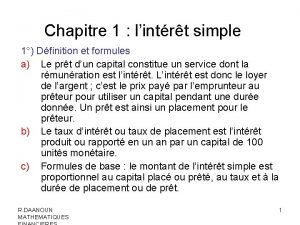Chapitre X threads Threads o Threads plusieurs activits




![Suite public static void main(String[] args) { new Thread. Affiche("PING", 10). start(); new Thread. Suite public static void main(String[] args) { new Thread. Affiche("PING", 10). start(); new Thread.](https://slidetodoc.com/presentation_image_h2/7e3062c69a16753bc1b8df3df1d26781/image-5.jpg)


![Suite public static void main(String[] args) { Runnable ping=new Runnable. Affiche("PING", 10); Runnable pong=new Suite public static void main(String[] args) { Runnable ping=new Runnable. Affiche("PING", 10); Runnable pong=new](https://slidetodoc.com/presentation_image_h2/7e3062c69a16753bc1b8df3df1d26781/image-8.jpg)


![Suite public static void main(String[] args) { X x=new X(); Thread un=new Concur("un", x); Suite public static void main(String[] args) { X x=new X(); Thread un=new Concur("un", x);](https://slidetodoc.com/presentation_image_h2/7e3062c69a16753bc1b8df3df1d26781/image-11.jpg)

![Suite public static void main(String[] args) { Y y=new Y(); Thread un=new Concur 1("un", Suite public static void main(String[] args) { Y y=new Y(); Thread un=new Concur 1("un",](https://slidetodoc.com/presentation_image_h2/7e3062c69a16753bc1b8df3df1d26781/image-13.jpg)










- Slides: 23

Chapitre X threads

Threads o Threads : plusieurs activités qui coexistent et partagent des données n exemples: o o o n problème de l'accès aux ressources partagées o o o thread pendant un chargement long faire autre chose coopérer processus versus threads verrous moniteur synchronisation POO-L 3 H. Fauconnier 2

Principes de base o extension de la classe Thread n n n thread méthode run est le code qui sera exécuté. la création d'un objet dont la superclasse est Thread crée la thread (mais ne la démarre pas) la méthode start démarre la thread (et retourne immédiatement) la méthode join permet d'attendre la fin de la thread les exécutions des threads sont asynchrones et concurrentes POO-L 3 H. Fauconnier 3

Exemple class Thread. Affiche extends Thread{ private String mot; private int delay; public Thread. Affiche(String w, int duree){ mot=w; delay=duree; } public void run(){ try{ for(; ; ){ System. out. println(mot); Thread. sleep(delay); } }catch(Interrupted. Exception e){ } } } thread POO-L 3 H. Fauconnier 4
![Suite public static void mainString args new Thread AffichePING 10 start new Thread Suite public static void main(String[] args) { new Thread. Affiche("PING", 10). start(); new Thread.](https://slidetodoc.com/presentation_image_h2/7e3062c69a16753bc1b8df3df1d26781/image-5.jpg)
Suite public static void main(String[] args) { new Thread. Affiche("PING", 10). start(); new Thread. Affiche("PONG", 30). start(); new Thread. Affiche("Splash!", 60). start(); } thread POO-L 3 H. Fauconnier 5

Alternative: Runnable o Une autre solution: n n thread créer une classe qui implémente l'interface Runnable (cette interface contient la méthode run) créer une Thread à partir du constructeur Thread avec un Runnable comme argument. POO-L 3 H. Fauconnier 6

Exemple class Runnable. Affiche implements Runnable{ private String mot; private int delay; public Runnable. Affiche(String w, int duree){ mot=w; delay=duree; } public void run(){ try{ for(; ; ){ System. out. println(mot); Thread. sleep(delay); } }catch(Interrupted. Exception e){ } } } thread POO-L 3 H. Fauconnier 7
![Suite public static void mainString args Runnable pingnew Runnable AffichePING 10 Runnable pongnew Suite public static void main(String[] args) { Runnable ping=new Runnable. Affiche("PING", 10); Runnable pong=new](https://slidetodoc.com/presentation_image_h2/7e3062c69a16753bc1b8df3df1d26781/image-8.jpg)
Suite public static void main(String[] args) { Runnable ping=new Runnable. Affiche("PING", 10); Runnable pong=new Runnable. Affiche("PONG", 50); new Thread(ping). start(); new Thread(pong). start(); } thread POO-L 3 H. Fauconnier 8

Synchronisation o les threads s'exécutent concurremment et peuvent accéder concurremment à des objets: n il faut contrôler l'accès: n n thread un lit une variable (R 1) puis modifie cette variable (W 1) thread deux lit la même variable (R 2) puis la modifie (W 2) R 1 -R 2 -W 1 R 1 -W 1 -R 2 -W 2 résultat différent! POO-L 3 H. Fauconnier 9

Exemple class X{ int val; } class Concur extends Thread{ X x; int i; String nom; public Concur(String st, X x){ nom=st; this. x=x; } public void run(){ i=x. val; System. out. println("thread: "+nom+" valeur x="+i); try{ Thread. sleep(10); }catch(Exception e){} x. val=i+1; System. out. println("thread: "+nom+" valeur x="+x. val); } } thread POO-L 3 H. Fauconnier 10
![Suite public static void mainString args X xnew X Thread unnew Concurun x Suite public static void main(String[] args) { X x=new X(); Thread un=new Concur("un", x);](https://slidetodoc.com/presentation_image_h2/7e3062c69a16753bc1b8df3df1d26781/image-11.jpg)
Suite public static void main(String[] args) { X x=new X(); Thread un=new Concur("un", x); Thread deux=new Concur("deux", x); un. start(); deux. start(); try{ un. join(); deux. join(); }catch (Interrupted. Exception e){} System. out. println("X="+x. val); } donnera (par exemple) o thread: un valeur x=0 o thread: deux valeur x=0 o thread: un valeur x=1 o thread: deux valeur x=1 o X=1 thread POO-L 3 H. Fauconnier 11

Deuxième exemple class Y{ int val=0; public int increment(){ int tmp=val; tmp++; try{ Thread. current. Thread(). sleep(100); }catch(Exception e){} val=tmp; return(tmp); } int get. Val(){return val; } } class Concur 1 extends Thread{ Y y; String nom; public Concur 1(String st, Y y){ nom=st; this. y=y; } public void run(){ System. out. println("thread: "+nom+" valeur="+y. increment()); } } thread POO-L 3 H. Fauconnier 12
![Suite public static void mainString args Y ynew Y Thread unnew Concur 1un Suite public static void main(String[] args) { Y y=new Y(); Thread un=new Concur 1("un",](https://slidetodoc.com/presentation_image_h2/7e3062c69a16753bc1b8df3df1d26781/image-13.jpg)
Suite public static void main(String[] args) { Y y=new Y(); Thread un=new Concur 1("un", y); Thread deux=new Concur 1("deux", y); un. start(); deux. start(); try{ un. join(); deux. join(); }catch (Interrupted. Exception e){} System. out. println("Y="+y. get. Val()); } -----o o o thread: un valeur=1 thread: deux valeur=1 Y=1 POO-L 3 H. Fauconnier 13

Verrous o à chaque objet est associé un verrou n synchronized(expr) {instructions} o o n thread expr doit s'évaluer comme une référence à un objet verrou sur cet objet pour la durée de l'exécution de instructions déclarer les méthodes comme synchronized: la thread obtient le verrou et le relâche quand la méthode se termine POO-L 3 H. Fauconnier 14

synchronised(x) class Concur extends Thread{ X x; int i; String nom; public Concur(String st, X x){ nom=st; this. x=x; } public void run(){ synchronized(x){ i=x. val; System. out. println("thread: "+nom+" valeur x="+i); try{ Thread. sleep(10); }catch(Exception e){} x. val=i+1; System. out. println("thread: "+nom+" valeur x="+x. val); } } } thread POO-L 3 H. Fauconnier 15

Méthode synchronisée class Y{ int val=0; public synchronized int increment(){ int tmp=val; tmp++; try{ Thread. current. Thread(). sleep(100); }catch(Exception e){} val=tmp; return(tmp); } int get. Val(){return val; } } ------ o o o thread: un valeur=1 thread: deux valeur=2 Y=2 POO-L 3 H. Fauconnier 16

Mais… o la synchronisation par des verrous peut entraîner un blocage: n n n o thread la thread un (XA) pose un verrou sur l'objet A et (YB) demande un verrou sur l'objet B la thread deux (XB) pose un verrou sur l'objet B et (YA) demande un verrou sur l'objet A si XA –XB : ni YA ni YB ne peuvent êter satisfaites -> blocage (pour une méthode synchronisée, le verrou concerne l'objet globalement et pas seulement la méthode) POO-L 3 H. Fauconnier 17

Exemple class Dead{ Dead partenaire; String nom; public Dead(String st){ nom=st; } public synchronized void f(){ try{ Thread. current. Thread(). sleep(100); }catch(Exception e){} System. out. println(Thread. current. Thread(). get. Name()+ " de "+ nom+". f() invoque "+ partenaire. nom+". g()"); partenaire. g(); } public synchronized void g(){ System. out. println(Thread. current. Thread(). get. Name()+ " de "+ nom+". g()"); } public void set. Partenaire(Dead d){ partenaire=d; } } thread POO-L 3 H. Fauconnier 18

Exemple (suite) final Dead un=new Dead("un"); final Dead deux= new Dead("deux"); un. set. Partenaire(deux); deux. set. Partenaire(un); new Thread(new Runnable(){public void run(){un. f(); } }, "T 1"). start(); new Thread(new Runnable(){public void run(){deux. f(); } }, "T 2"). start(); ------ o o thread T 1 de un. f() invoque deux. g() T 2 de deux. f() invoque un. g() POO-L 3 H. Fauconnier 19

Synchronisation… o wait, notify. All notify n attendre une condition / notifier le changement de condition: synchronized void fairesurcondition(){ while(!condition){ wait(); faire ce qu'il faut quand la condition est vraie } --------synchronized void changercondition(){ … changer quelque chose concernant la condition notify. All(); // ou notify() } thread POO-L 3 H. Fauconnier 20

Exemple (file: rappel Cellule) public class Cellule<E>{ private Cellule<E> suivant; private E element; public Cellule(E val) { this. element=val; } public Cellule(E val, Cellule suivant){ this. element=val; this. suivant=suivant; } public E get. Element(){ return element; } public void set. Element(E v){ element=v; } public Cellule<E> get. Suivant(){ return suivant; } public void set. Suivant(Cellule<E> s){ this. suivant=s; } thread POO-L 3 H. Fauconnier 21

Files synchronisées class File<E>{ protected Cellule<E> tete, queue; private int taille=0; public synchronized void enfiler(E item){ Cellule<E> c=new Cellule<E>(item); if (queue==null) tete=c; else{ queue. set. Suivant(c); } c. set. Suivant(null); queue = c; notify. All(); } thread POO-L 3 H. Fauconnier 22

File (suite) public synchronized E defiler() throws Interrupted. Exception{ while (tete == null) wait(); Cellule<E> tmp=tete; tete=tete. get. Suivant(); if (tete == null) queue=null; return tmp. get. Element(); } thread POO-L 3 H. Fauconnier 23
 L'échéance moyenne
L'échéance moyenne Accord du verbe avec plusieurs sujets
Accord du verbe avec plusieurs sujets Alexandrine lambert
Alexandrine lambert Petit pays chapitre par chapitre
Petit pays chapitre par chapitre Résumé chapitre par chapitre tirez pas sur le scarabée
Résumé chapitre par chapitre tirez pas sur le scarabée Le petit prince résumé simple
Le petit prince résumé simple Le petit prince résumé chapitre par chapitre
Le petit prince résumé chapitre par chapitre Grammaire 1 chapitre 5
Grammaire 1 chapitre 5 La petite fille au kimono rouge lecture suivie
La petite fille au kimono rouge lecture suivie The pronoun y chapitre 3
The pronoun y chapitre 3 1 pierre chapitre 5
1 pierre chapitre 5 Chapitre 2 vocabulaire 1
Chapitre 2 vocabulaire 1 Chapitre 2 richesse et pauvreté dans le monde
Chapitre 2 richesse et pauvreté dans le monde Le petit prince chapitre 12
Le petit prince chapitre 12 Jean chapitre 8
Jean chapitre 8 Le petit prince chapitre 6
Le petit prince chapitre 6 Chapitre 14 cinquieme rencontre
Chapitre 14 cinquieme rencontre Chapitre fonction seconde
Chapitre fonction seconde Carte chapitre 1
Carte chapitre 1 Le petit prince chapitre 13
Le petit prince chapitre 13 Matthieu chapitre 26
Matthieu chapitre 26 Maria chapdelaine résumé par chapitre
Maria chapdelaine résumé par chapitre Jsus christ
Jsus christ La prire
La prire













































